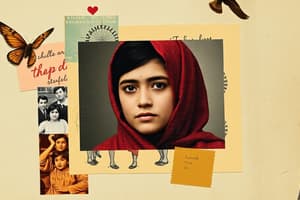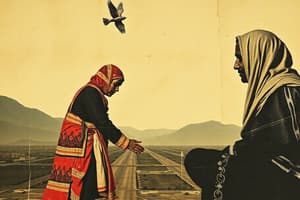Podcast
Questions and Answers
What cultural value is most exemplified by the constant stream of visitors in Malala's childhood home?
What cultural value is most exemplified by the constant stream of visitors in Malala's childhood home?
- The importance of familial ties and obligations to relatives regardless of distance.
- The Pashtunwali code's emphasis on hospitality and welcoming guests. (correct)
- The central role of women in maintaining social connections within the community.
- The desire to share resources and support those less fortunate in neighboring towns.
From Malala's perspective, which aspect of the men's gatherings was most appealing despite her young age?
From Malala's perspective, which aspect of the men's gatherings was most appealing despite her young age?
- The manner of communication and the exchange of ideas within the group. (correct)
- The sense of camaraderie and shared purpose in addressing community challenges.
- The opportunity to learn about complex political issues directly from community leaders.
- The structured and respectful approach to debating diverse viewpoints.
How does the text suggest the women's behavior and appearance differed between private and public settings?
How does the text suggest the women's behavior and appearance differed between private and public settings?
- Women's attire became more elaborate and colorful in public to assert their social status and individuality.
- Women adopted more assertive and leadership-oriented roles in public compared to the domestic sphere.
- Women prioritized intellectual discussions and political engagement in the home, while focusing on social pleasantries in public.
- Women displayed a greater sense of freedom and expressiveness within the private sphere, contrasting with their more reserved public demeanor. (correct)
What does Malala's observation of women adhering to purdah reveal about the societal expectations placed upon them?
What does Malala's observation of women adhering to purdah reveal about the societal expectations placed upon them?
How did observing the women around her influence Malala's personal views on freedom and self-expression?
How did observing the women around her influence Malala's personal views on freedom and self-expression?
What can be inferred from Malala's statement: 'Although I wasn't particularly skilled in the kitchen, I recognized the value of a life lived openly.'?
What can be inferred from Malala's statement: 'Although I wasn't particularly skilled in the kitchen, I recognized the value of a life lived openly.'?
How does the narrative connect the physical act of veiling to the broader concept of freedom and personal expression for women?
How does the narrative connect the physical act of veiling to the broader concept of freedom and personal expression for women?
What does Malala's early questioning of purdah suggest about her personality?
What does Malala's early questioning of purdah suggest about her personality?
Considering the cultural context, why might the women have removed their headscarves and veils inside the women's quarters?
Considering the cultural context, why might the women have removed their headscarves and veils inside the women's quarters?
How does the contrast between the men's and women's spaces contribute to the story's broader themes?
How does the contrast between the men's and women's spaces contribute to the story's broader themes?
Flashcards
Pashtunwali Code
Pashtunwali Code
A traditional code of conduct among the Pashtun people emphasizing hospitality and honor.
Hospitality
Hospitality
The friendly and generous reception of guests or strangers.
Purdah
Purdah
The practice of secluding women from public observation, often involving specific clothing.
Niqab
Niqab
Signup and view all the flashcards
Burqa
Burqa
Signup and view all the flashcards
Men's Guest Room
Men's Guest Room
Signup and view all the flashcards
Women’s Quarters
Women’s Quarters
Signup and view all the flashcards
Cousin Relationships
Cousin Relationships
Signup and view all the flashcards
Childhood Observations
Childhood Observations
Signup and view all the flashcards
Freedom Reflection
Freedom Reflection
Signup and view all the flashcards
Study Notes
Personal Experiences Growing Up
- Author's childhood home was always full of people, including relatives, neighbours, and many cousins
- Shared a home with cousins, even when moving, often sleeping on floors due to hospitality customs
- Women in the home would gather on the veranda, while men stayed in a separate room.
- Author spent time with both groups, observing political discussions and other important matters
Pashtunwali Culture
- Hospitality is a key part of Pashtunwali culture
- Author's family embraced this by welcoming visitors
- Always opened their doors to guests
Women's Roles and Customs
- Women covered themselves when out in public, with various levels of coverage.
- Some women wore niqab (scarves over faces) or burqas (full body coverings)
- Author's mother followed the customs
- Women showed limited skin while in public
- Women walked behind their husbands
- Women's interactions were private, author observed them with a sense of separation
- Teenage girls' movements were restricted more as they aged
Observations of Societal Differences
- Author saw a difference in interactions between men and women
- Women's lives seemed different, with gentle whispers, some laughter, and more powerful laughter
- Beautiful women, with vivid makeup, were impressive
- Women's beauty was appreciated publicly despite customs
- Author felt a sense of unease about women's limited freedom
- Author's view of the world was expanded by seeing women's interactions
- Author didn't understand the politics fully
Author's Feelings and Perspective
- Author observed both sides of the customs and societal rules
- Was interested in men's discussions on politics.
- Found men's discussions intriguing and sought to learn more
- Felt the women's freedom was limited by traditional practices
- Tried to understand and avoid the kitchen as she preferred other activities.
- Felt being in hiding was unfair and uncomfortable
Studying That Suits You
Use AI to generate personalized quizzes and flashcards to suit your learning preferences.



